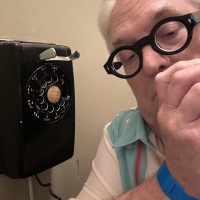Home » Jazz Articles » Book Review » Jazz in the New Millennium: Live and Well by Rick Mitchell
Jazz in the New Millennium: Live and Well by Rick Mitchell
 Jazz in the New Millennium: Live and Well
Jazz in the New Millennium: Live and Well Rick Mitchell
339 Pages
ASIN: #B00N2331GC
Dharma Moon
2014
Much of jazz analysis and reportage is history; the exposition and re-exposition of old forms and older artists. Precious few books written about jazz today have contemporary artists or movements as their subject. Rick Mitchell's Jazz in the New Millennium: Live and Well happily flies in the face of the old with an eye on the present and new. His book is expansive, addressing among the "Living Masters," one Roy Haynes (b. 1925) to a "Rising Star" in Esperanza Spalding and Gerald Clayton (b. 1984). While that expanse includes bebop to the present, there are no exposes on Charlie Parker, Dizzy Gillespie or Miles Davis. Mitchell's book is devoted to those musicians living while it was compiled.
In 2000, Mitchell left his post as jazz and popular music critic at the Houston Chronicle to become a teacher and programming consultant for the Houston International Music Festival, Da Camera of Houston. The Da Camera coupled jazz and classical performance and survived only a couple of seasons as such while the jazz portion continued on its own. Mitchell wrote the program notes for the series and out of those Jazz in the New Millennium: Live and Well arose.
Mitchell organized his book around three groups of musicians: the aforementioned "Living Masters" and "Rising Stars" sandwiching the largest group under consideration "Prime Time Players." As such, Mitchell could not have made a completest list of any category as his subject matter was dependent on who was performing. That said, his lists are impressive. Included as "Living Masters" are Haynes, Randy Weston, Dave Holland, Kenny Barron and Wayne Shorter. Shorter's section, "Without a Net" details the saxophonist's 21st Century acoustic quartet including pianist Danilo Pérez (who is also a "Prime Time Player"), bassist John Patitucci, and drummer Brian Blade. At 81 at this writing, Shorter comes full circle with his most provocative music.
Among the "Prime Time Players" are saxophonist Joshua Redman, trumpeter Dave Douglas, violinist Regina Carter, and vocalist Cassandra Wilson. Wilson's importance to jazz vocals since the 1990s cannot be over-estimated. She redefined jazz vocals with Blue Light 'til Dawn (Blue Note, 1993) and New Moon Daughter (Blue Note, 1995). She covered Robert Johnson, Van Morrison, and Joni Mitchell with equal aplomb while establishing a new band format including instruments better associated with folk and blues. Taking her cue from Miles Davis wide-open performance of "My Man's Gone Now" on We Want Miles (Columbia, 1982), Wilson put her stamp on all of the jazz vocals coming after.
In the "Rising Stars" section, Mitchell presents the widest variety of influences in pianists Jason Moran, Hiromi, and, Robert Glasper, bassists Pablo Aslan and Esperanza Spalding, clarinetist Anat Cohen, trumpeter Ambrose Akinmusire and Latin Jazz phenom Manuel Valera, whose In Motion (Criss Cross, 2014) with the New Cuban Express has produced progressive music that plows new fields yet retains that element of authenticity that makes what Dizzy Gillespie called "Afro-Cubano" sting with pleasure.
Mitchell displays his acute grasp of the music and its meanings and how each of the artists he spotlights fits into that modern picture of jazz and beyond. An easy and informative read for those wanting to know who performing today in jazz are the first to go to once the classic performers are assimilated into collections and playlists.
Tags
Roy Haynes
Book Reviews
C. Michael Bailey
Esperanza Spalding
Gerald Clayton
Charlie Parker
Dizzy Gillespie
Miles Davis
Randy Weston
Dave Holland
Kenny Barron
Wayne Shorter
Danilo Perez
John Patitucci
Brian Blade
Joshua Redman
Dave Douglas
Regina Carter
Cassandra Wilson
robert johnson
Van Morrison
Joni Mitchell
jason moran
Hiromi
Robert Glasper
Pablo Aslan
Anat Cohen
ambrose akinmusire
Manuel Valera
PREVIOUS / NEXT
Support All About Jazz
 All About Jazz has been a pillar of jazz since 1995, championing it as an art form and, more importantly, supporting the musicians who make it. Our enduring commitment has made "AAJ" one of the most culturally important websites of its kind, read by hundreds of thousands of fans, musicians and industry figures every month.
All About Jazz has been a pillar of jazz since 1995, championing it as an art form and, more importantly, supporting the musicians who make it. Our enduring commitment has made "AAJ" one of the most culturally important websites of its kind, read by hundreds of thousands of fans, musicians and industry figures every month.





















